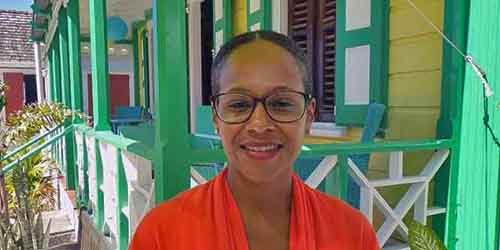The site DossierKoninkrijksrelaties has a new columnist from Saba: freelance journalist Hazel Durand.
Enjoy her first contribution to the site.

Building Saba’s Future: Female Engineers Lead Major Infrastructure Projects
At just five square miles, Saba may be small, but the island’s ambitions are anything but. Despite its limited footprint, this Caribbean gem continues to forge ahead with ambitious infrastructure developments designed to serve its growing population and secure its place in a rapidly evolving world.
For my first contribution as a freelance journalist returning to my homeland, I sat down with two remarkable women who are quite literally shaping Saba’s future: Zelda Meeuwsen, head of the Department of Infrastructure and Spatial Planning, and Carine Ghazzi, project manager for construction. Together, they’re overseeing two transformative projects—the development of Black Rocks Harbor and a comprehensive expansion of educational facilities at St. John’s.
A Fresh Start for St. John’s School
During the summer holidays, the rhythmic crash of falling boulders echoed through St. John’s village as the school’s nearly forty-year-old sports hall came tumbling down. For many residents, the building holds bittersweet memories—not just of games and gatherings, but of persistent roof leaks that plagued the facility from early on. Despite countless repair attempts, the problems never truly resolved, leaving demolition as the only viable option.
“The current sports hall does not meet international standards to organize basketball tournaments, for example,” explains Ghazzi, who holds a bachelor’s degree in architecture and a master’s in real estate management. Having spent seven years working in Curaçao, she brings valuable regional expertise to her role overseeing the project. “So officially, no international or island competitions can take place there.”
The new sports hall, funded by the Ministry of Health, Welfare and Sport (VWS), will span approximately 900 square meters and comply with Dutch safety regulations and international standards. But the transformation of St. John’s extends far beyond athletics.
Perhaps most exciting is the development of new technical facilities covering over 1,000 square meters. Currently, Saba Comprehensive School’s technology classrooms sit outside the main campus, limiting their accessibility and appeal. The expansion will bring these facilities on-site, featuring workshops, technical drawing classrooms, and even space for automotive engineering.
“We need a lot of contractors and technical professionals,” Ghazzi emphasizes. “So with the modern facility, we also hope that part of the education will become more attractive for the children.”
The timing couldn’t be more critical. As Saba continues to develop, the demand for skilled tradespeople and technical professionals grows. By investing in state-of-the-art educational facilities, the island is investing in its future workforce.
Construction of both the sports hall and technical facilities is scheduled to begin early next year, with completion expected within two years. Given St. John’s particularly windy location, all new buildings will be constructed to withstand category 5 hurricanes—a sobering but essential requirement in this hurricane-prone region.
An Enrichment Center for the Entire Community
The vision for St. John’s doesn’t stop there. Between the technical school and sports hall, an Enrichment Center is planned, financed through a 5 million euro Regional Deal. This multipurpose facility will feature an auditorium equipped with a kitchen, serving both primary and secondary schools while remaining available to the broader community for events, conferences, theatrical performances, and concerts.
The center’s design also addresses a practical concern: traffic congestion during school hours. Plans include additional parking spaces and a roundabout for drop-off and pick-up to ease the flow of vehicles during peak times.
“There will be a lot of construction in St. John’s over the next two, three, four years,” Ghazzi notes with a mixture of excitement and pragmatism.
A master plan envisions what St. John’s facilities could look like twenty years from now, potentially including bridges connecting the primary and secondary schools, eventually linking both to the Enrichment Center. Of course, such grand visions depend on available funding, but the blueprint for transformation is in place.
Black Rocks Harbor: A Gateway to Economic Growth
While St. John’s undergoes its metamorphosis, attention also turns to Saba’s coastline, where the long-awaited Black Rocks Harbor is finally taking shape. A temporary camp currently under construction will soon house more than 100 workers arriving to tackle this massive undertaking.
The project begins with essential infrastructure: utilities and water pipes installed along a new road that will open up previously inaccessible parts of the island for future development. This road will also provide access to Saba Electric Company N.V.’s planned solar park—another step toward sustainability.
The temporary workers’ camp itself has sparked considerable local interest. According to Meeuwsen, who holds a master’s degree in architecture from Delft University of Technology, the facility will include dormitories, a kitchen, offices, workshops, and recreational spaces. The core construction will commence once hurricane season ends.
The harbor development will begin with a new breakwater extending toward the coast. Once this primary structure is complete, construction will continue within the port itself: wharves, finger piers, and boat berths. The ambitious timeline calls for the main breakwater to be ready before next hurricane season begins in June.
“What you will see then is the breakwater, the quays, the boat moorings, and the different levels on land where we can build buildings in the future,” Meeuwsen explains. “The buildings and the port office will be developed after the main structures of the port are ready.”
Meeuwsen acknowledges the challenge of working within the narrow window between hurricane seasons. Extensive preparations have been made to ensure that once construction begins, the breakwater can be completed before the next storm season arrives.
The project has attracted attention from neighboring islands, who have reached out for advice on design, contractors, environmental considerations, and tendering procedures. “Certainly, the other islands are looking at us,” Meeuwsen says, “and we are obviously trying to provide them with advice, and we are also trying to learn from their first steps in creating a new port facility.”
Three Pillars of Funding
Preparations for Black Rocks Harbor began in 2017, with funding from the Ministry of Infrastructure and Water Management and the Ministry of the Interior and Kingdom Relations contingent on three main criteria.
First, the port must be hurricane-proof. The design has been tested to withstand waves from a category 5 hurricane—a non-negotiable requirement in the Caribbean.
Second, the port must be future-proof. “Because we are so dependent on imports, we need to make sure that we can still receive cargo vessels in the future, even when they get bigger, which is a trend we are seeing,” Meeuwsen explains.
To address this, the existing Fort Bay Harbor will be modified to accommodate larger cargo ships and will serve as the primary freight port, while Black Rocks will function as a backup facility should problems arise at Fort Bay.
The third criterion focuses on economic development. The new harbor is expected to stimulate growth throughout the island by attracting mega yachts, serving the local fleet and ferries, and creating employment opportunities. While some yacht owners currently visit Saba, many feel uncomfortable with the existing moorings.
“We certainly think there is a market to receive more visiting yachts or recreational vessels, and of course, this will create jobs,” Meeuwsen notes.
Beyond immediate construction employment—which will benefit local contractors and suppliers—the port will require permanent staff for operations. New businesses, including restaurants, may emerge in the port area, further boosting the local economy.
The master plan for Black Rocks Harbor, still under development, envisions an attractive destination for both residents and tourists. “It should become a very attractive area where both Sabanese and tourists can spend their free time,” Meeuwsen says. “People also like to go to Fort Bay, especially on Sundays. There we hear, for example, that there is a lack of shade, and certain facilities are lacking. We really want to introduce these kinds of things at Black Rocks.”
Breaking Barriers in a Male-Dominated Field
Both Ghazzi and Meeuwsen studied at Delft University of Technology, and both have chosen to build their careers in what remains a predominantly male industry. When asked for advice to young women considering careers in engineering and construction, their responses were immediate and passionate.
“I think women in the construction industry, I can say, are better, right?” Ghazzi says with a smile. “They really add value because they are much more detailed, which is important in construction. It often seems like you’re just going to pour concrete and that’s it, but it’s all about the details and the finish, which really determine the success of a project. And I always think women can look further ahead, so they can think ten steps ahead, and that’s really important.”
Her message to young women is simple: don’t be afraid to enter this world.
Meeuwsen’s journey to Saba began as a trainee at the Ministry of Interior and Kingdom Relations. “I went to Saba for six months and fell in love with the island and also with someone on the island,” she laughs. She relocated permanently in 2020, starting as an Assistant Project Manager for the port project before becoming head of department three years later.
With several major projects on the horizon, she emphasizes the need for young local talent. “Sometimes it’s really good to hear the opinion of young people. I would really encourage them to explore this field for their future careers, or Sabans living abroad, I encourage them to come back and contribute to these projects.”
Building Tomorrow, Today
As Saba embarks on these ambitious infrastructure projects, the island demonstrates that size need not limit vision. From hurricane-resistant school buildings to a world-class harbor facility, these developments represent more than concrete and steel—they represent investment in education, economic opportunity, and the island’s long-term sustainability.
Under the leadership of engineers like Meeuwsen and Ghazzi, Saba continues to lead the way, proving that even the smallest islands can dream big and build bigger. The next few years will transform not just the physical landscape of Saba, but potentially its economic prospects and quality of life for generations to come.
For young Sabans watching bulldozers and cranes reshape their island, the message is clear: the future is being built right now, and there’s room for them to help shape it.
Hazel Durand

 Saba News News and Information from Saba Island, Dutch Caribbean
Saba News News and Information from Saba Island, Dutch Caribbean
